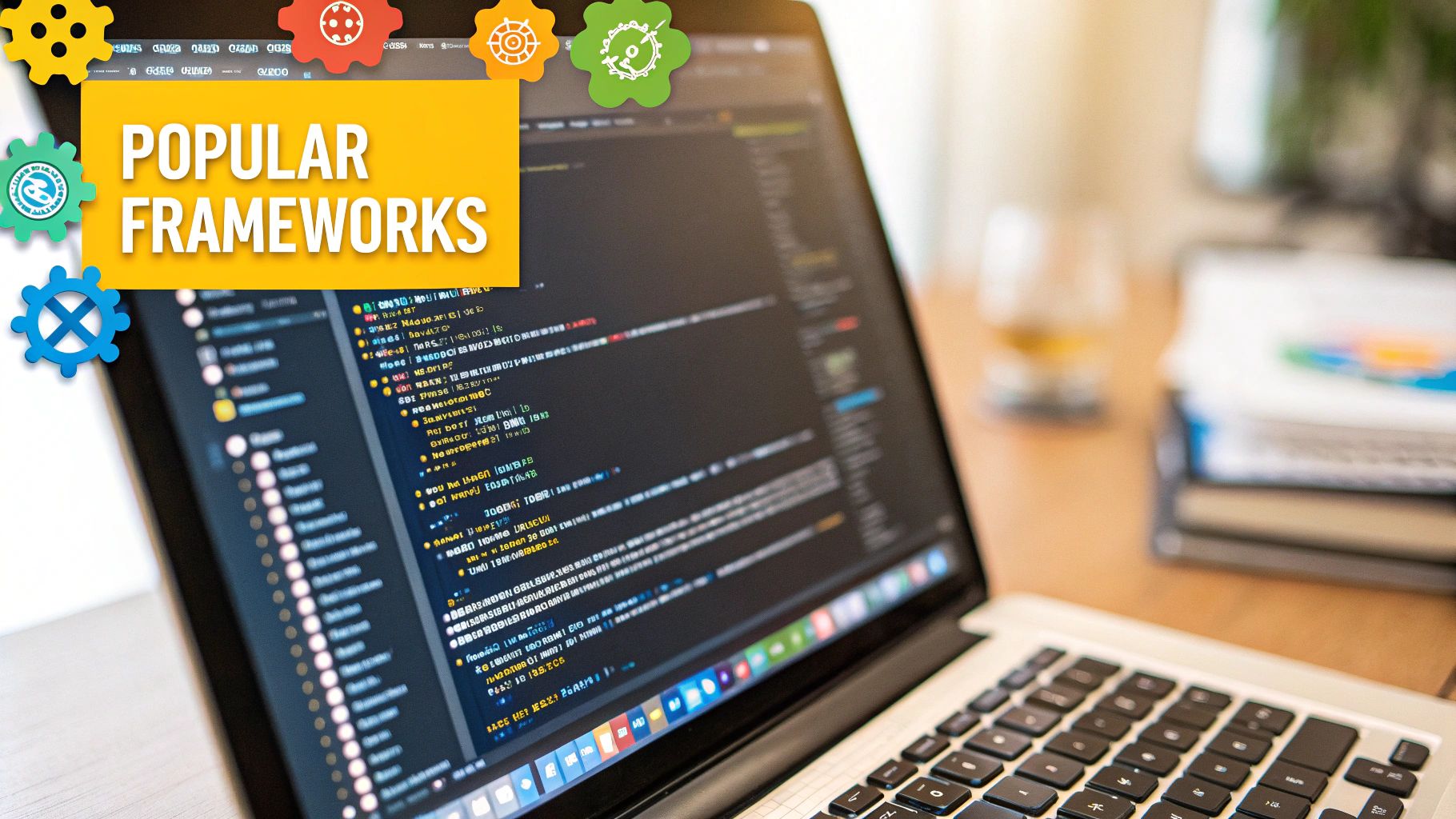Mobile App Cross Platform Development: Your Ultimate Guide

Cross-platform mobile app development is a way to build a single application that works seamlessly across different operating systems, like iOS and Android. Instead of building two separate apps from the ground up, your team writes the code just once and can deploy it on multiple platforms. This is a huge advantage for businesses aiming to connect with a larger audience without doubling their budget and timeline.
What Is Cross-Platform App Development?

Think of it like this: traditional native development is like writing a book in English for an American audience and then hiring a separate translator and typesetter to create a completely new version in Spanish for a different market. You’re managing two separate projects.
Cross-platform development, on the other hand, is like writing that book in a universal language that both audiences can instantly understand. You write it once, and it’s ready for everyone. This "write once, run anywhere" philosophy is what makes it so powerful.
A Quick Look at Native vs. Cross-Platform
To really get a handle on the differences, it helps to see the two approaches side-by-side. The traditional native path has its strengths, particularly for performance-heavy apps, but the cross-platform model brings a level of efficiency that's hard to ignore.
Here’s a simple breakdown of how they compare on the factors that matter most to businesses and development teams.
| Factor | Native Development | Cross-Platform Development |
|---|---|---|
| Codebase | Separate code for each platform (e.g., Swift for iOS, Kotlin for Android) | A single, shared codebase for multiple platforms |
| Development Team | Requires specialized teams for each OS, often doubling labor costs | One team can build and maintain the app for all platforms |
| Time to Market | Slower, as two apps are built concurrently or sequentially | Significantly faster, with simultaneous launch on iOS and Android |
| Cost | Higher initial and ongoing costs due to dual development tracks | More cost-effective, with lower initial investment and maintenance |
| User Experience | Can achieve the highest level of performance and platform-specific UI | Excellent performance for most apps, with a near-native look and feel |
| Maintenance | Updates and bug fixes must be implemented and tested on each codebase | Easier and faster; fix a bug once, and it’s fixed everywhere |
While native development gives you exacting control over every pixel and function for a specific OS, cross-platform development offers a practical, resource-smart path to reaching the entire mobile market.
The Power of a Single Codebase
At its heart, the magic of cross-platform development comes from working with a single, unified codebase. This simple fact has a ripple effect, streamlining the entire process from the first line of code to ongoing updates. For businesses, this efficiency creates some serious advantages.
By sharing one codebase, you unlock benefits like:
- Faster Rollouts: You can launch on the App Store and Google Play at the same time, grabbing the attention of the entire market right from the start.
- Lower Development Costs: You don’t need to fund two separate development teams. This cuts down one of the biggest expenses in app creation.
- Simpler Maintenance: When a bug pops up or you want to add a cool new feature, your team makes the change once. That fix then rolls out to every platform your app supports.
This unified approach allows businesses to maximize their market reach without needing to create separate apps for each operating system. The rapid development cycle that cross-platform tools enable shortens time-to-market substantially, a critical advantage in competitive environments.
This strategy truly delivers on the "write once, run everywhere" promise. Research in the field highlights just how effective this is, showing that developers can reduce their total effort by up to 80% because one codebase does the work of two or more. And when it’s time for updates, maintenance is far cheaper and faster. If you'd like to dig deeper, you can read the full research on cross-platform development efficiency. This fundamental shift has made building a quality mobile presence a realistic goal for more businesses than ever.
Why Businesses Are Choosing Cross-Platform

The decision to go with cross-platform development over building separate native apps isn't just a technical one—it's a core business strategy. For a growing number of companies, the real-world return on investment is just too compelling to ignore. It directly impacts everything from the budget to your position in the market.
Think about it this way: you're ready to launch a new e-commerce app. The market is pretty much split down the middle between iOS and Android users. If you stick with the traditional native path, you're immediately faced with a tough choice. Do you launch on just one platform, effectively ignoring half of your potential customers? Or do you find the money and time to double your development effort from the get-go?
Cross-platform development neatly sidesteps that entire problem. It lets you launch on both platforms at the same time, instantly giving you access to the entire market on day one. This broad reach is a massive advantage for user acquisition, giving your app a much better shot at gaining real traction in a crowded marketplace.
Slashing Development Costs and Timelines
One of the biggest draws for any business is the significant cut in development costs. Instead of bankrolling two separate, specialized teams—one for iOS, one for Android—you can get the job done with a single, more versatile team. That consolidation alone adds up to major savings.
A single codebase is the key. Your team writes the app's core logic and builds its features just once, and that efficiency leads to a much faster development cycle. The benefits are clear:
- Reduced Labor Costs: It’s simple math. One development team costs a lot less to fund and manage than two.
- Faster Time-to-Market: Getting your app into the hands of users on both iOS and Android simultaneously means you can start bringing in revenue and collecting valuable feedback well before competitors who took the longer native route.
- Streamlined Maintenance: When it’s time to push an update or squash a bug, the fix is made once. The update then rolls out to both platforms, effectively cutting your long-term maintenance workload in half.
In a direct comparison, a cross-platform app can be about 30% cheaper to build than creating separate iOS and Android apps. That cost-effectiveness comes from having one project where huge chunks of code are simply reused.
This kind of efficiency is a game-changer, especially for startups and businesses working with a tight budget. It makes a high-quality mobile app an attainable goal instead of a costly risk.
Gaining a Competitive Edge
The app economy is booming. Projections show the global mobile app development market is on track to hit an incredible $626.39 billion by 2030. And with 79% of smartphone users having made a purchase on an app in the last six months, being on mobile is non-negotiable for driving revenue. Native development can run anywhere from $50,000 to over $300,000, but modern cross-platform tools have made it far more affordable to get in the game. You can explore detailed mobile app development insights to see the full picture.
This is where the speed of mobile app cross-platform development becomes a secret weapon. When you get to market faster, you can start building your brand, grabbing market share, and creating a loyal user base while your competitors are still in development.
It also makes keeping your brand experience consistent a whole lot easier. Because the app stems from a shared codebase, the core features, look, and feel are naturally uniform across both iOS and Android. This consistency reinforces your brand and ensures users get the same great experience, no matter what phone they're using. You avoid those small but frustrating differences that pop up when two separate teams interpret the same design brief in slightly different ways.
Comparing the Top Cross-Platform Frameworks
Choosing the right cross-platform framework is a lot like picking the engine for a new car. They all promise to get you to your destination—a working app on both iOS and Android—but the journey, performance, and the tools you use along the way can be worlds apart. The market is largely a two-horse race between React Native and Flutter, but other powerful options like .NET MAUI are definitely worth a look.
To really get a feel for these frameworks, you have to look past the feature lists and understand their core philosophies. React Native is like a clever diplomat. It uses JavaScript, a language spoken by millions of web developers, and creates a "bridge" to communicate with the native UI components of the device. This means your app uses the actual building blocks of iOS and Android, so it looks and feels right at home on either platform.
Flutter, on the other hand, is the master artist. Backed by Google, it uses its own language, Dart, and brings its own high-performance rendering engine, Skia, to the party. Instead of asking the phone to use its native buttons or lists, Flutter paints every single pixel on the screen itself. This gives you incredible control and ensures your app looks exactly the same everywhere.
This fundamental difference in architecture is the key to understanding the trade-offs you'll make in performance, developer experience, and the final user interface.
React Native vs Flutter Head-to-Head Comparison
The friendly rivalry between React Native and Flutter has pushed cross-platform development forward in massive ways. React Native is currently the most popular non-native framework on the Apple App Store, with its market share growing from 4.73% in 2022 to 6.75% in 2024. Not to be outdone, Flutter leads in the sheer volume of apps on Android, capturing an impressive 11.07% of the market in 2024. As these modern tools rise, older frameworks like Cordova and Ionic have naturally seen their usage decline.
So, how do the two giants really stack up against each other? Let's break it down feature by feature.
| Feature | React Native | Flutter |
|---|---|---|
| Underlying Language | JavaScript/TypeScript | Dart |
| UI Approach | Uses native UI components via a "bridge" | Renders its own UI with the Skia engine |
| Performance | Excellent, but the bridge can be a bottleneck in complex animations | Near-native performance due to direct compilation to ARM code |
| Developer Ecosystem | Mature and vast, leveraging the huge JavaScript community | Growing rapidly with strong backing from Google |
| Learning Curve | Easier for existing web developers familiar with React | Steeper if new to Dart, but the tooling is excellent |
| Community Support | Massive, with countless third-party libraries and resources | Highly active and growing, with extensive packages on pub.dev |
Ultimately, this table highlights the central decision you need to make. Do you value the truly native feel and the massive, mature ecosystem of React Native? Or do you prefer the pixel-perfect control, visual consistency, and blazing-fast performance that Flutter offers? There's no single right answer—it all depends on your project's specific needs.
A Closer Look at Flutter
Google's Flutter has won a lot of fans with its "UI as code" approach. In Flutter, everything you see on the screen—from a simple button to the padding around it—is a widget that you can customize down to the last detail.

This screenshot from Flutter's official website shows just how beautiful and expressive these UIs can be. The framework makes it possible to create a stunning experience that looks and feels identical across mobile, web, and even desktop, all from one codebase. For brands obsessed with a consistent look, this is a huge advantage.
Other Players in the Game
While React Native and Flutter steal most of the headlines, they aren't your only choices. .NET MAUI (Multi-platform App UI) from Microsoft is another heavyweight contender. It's the next evolution of Xamarin.Forms, empowering C# and .NET developers to build native apps for iOS, Android, Windows, and macOS from a single, shared codebase. For any company already invested in the Microsoft tech stack, it’s a natural and powerful fit.
Choosing the right framework often has less to do with which one is technically "best" and more to do with your team's skills and project goals. A team of C# pros will get up to speed with .NET MAUI much faster than if they had to learn Dart for Flutter from scratch.
If you want to dig deeper into the specific pros and cons of all the major players, you should check out a detailed comparison of the best cross-platform frameworks.
In the end, your framework choice has a direct impact on your app's architecture and how well it performs. While some frameworks compile directly to native code for amazing speed, others rely on a bridge that can sometimes slow things down. No matter what you choose, focusing on optimization is critical. You can learn more about how to https://getnerdify.com/blog/improve-app-performance in our dedicated guide. Picking the right framework is just the first step, but it’s one of the most important ones you'll take.
Is Cross-Platform Development the Right Call for Your App?
Picking between native and cross-platform development is one of those big, early decisions that will shape your entire mobile app project. There’s no single "best" answer here. It really comes down to what makes the most sense for your specific goals, your budget, and how quickly you need to get to market.
Think of it like choosing a vehicle for a road trip. A nimble sports car is perfect for hugging coastal highways, but a rugged SUV is what you need for a mountain adventure. Both are great cars, but one is clearly a better fit for the journey ahead. You have to match your development approach to the demands of your app.
This guide will walk you through the key questions you should be asking to make sure you're picking the right path.
How Much Performance Do You Really Need?
First things first, let's talk about performance. How much raw power does your app actually require? While today’s cross-platform frameworks are impressively fast—often feeling indistinguishable from native for most apps—some projects have performance demands that can only be met by going native.
These are the kinds of apps where native development often shines:
- High-End 3D Games: If you're building a game with intense graphics, complex physics, and zero tolerance for lag, you’ll want direct access to the device's GPU. Native gives you that raw, unfiltered power.
- Augmented Reality (AR) Experiences: AR apps need incredibly low latency to convincingly overlay digital information onto the real world. A native build provides the most direct and efficient connection to the device's camera and sensors.
- Apps with Heavy Background Tasks: If your app is constantly crunching numbers or processing data in the background, a native approach can sometimes offer better stability and more efficient use of system resources.
But here’s the thing: most apps don’t fall into these extreme categories.
For the vast majority of apps out there—think e-commerce, social media, or news readers—the performance difference between native and cross-platform is negligible. In these cases, the development speed and cost savings of a cross-platform approach easily win out.
If your app is a pretty standard business or utility tool, a mobile app cross-platform development strategy will deliver the smooth, responsive experience your users expect.
What About UI and Native Features?
Next up, you need to think about your app’s user interface (UI) and whether it needs to tap into very specific, platform-exclusive features. How deep does your integration with the operating system need to be?
Here are a few questions to guide your thinking:
Does your app need a "pixel-perfect" native look? If you absolutely must have your app look and feel exactly like a stock iOS or Android application, using their default UI controls, then native is the most direct route. On the other hand, many top brands now prefer a consistent, branded UI that looks the same everywhere, which is something frameworks like Flutter do exceptionally well.
Are you chasing brand-new OS features? Each year, Apple and Google launch new OS versions with unique, headline-grabbing features. Native apps can access these on day one through official SDK updates. Cross-platform frameworks usually need a short grace period for the community to build bridges to these new tools. If being the very first to use a new iOS or Android feature is critical to your strategy, native has a clear advantage.
Is your app relatively straightforward? For most e-commerce stores, social apps, internal business tools, and content-based platforms, the UI and feature sets are well-trodden territory. All the major cross-platform frameworks handle these use cases beautifully, making them perfect candidates for a shared codebase.
Ultimately, it’s a trade-off. If your priorities are a fast launch, broad reach, and keeping costs in check for a standard app, cross-platform is a fantastic choice. But if you’re building a highly specialized tool that needs to wring every ounce of performance out of a single OS, then native is likely the smarter way to go.
Best Practices For Building Great Cross-Platform Apps

Building a successful cross-platform app goes way beyond just sharing code. It’s really about creating an experience that feels intuitive and polished on any device a person might pick up. The goal isn't a "one-size-fits-all" app but rather a single, smart product that adapts beautifully to its environment.
This means you need a platform-aware mindset. You have to respect the unique design languages and user expectations of both iOS and Android, all while reaping the benefits of a single codebase. Stick to these proven practices, and you'll sidestep the common traps and deliver an app that users on both sides of the aisle will actually enjoy using.
Embrace Platform-Aware Design
The single biggest mistake I see developers make is trying to shoehorn one UI design onto both iOS and Android. It just doesn't work. Users have deep-seated expectations for how an app should look, feel, and navigate on their phone. An app with Android’s Material Design navigation on an iPhone feels jarring and out of place.
Your design has to be flexible. Thankfully, modern frameworks like React Native and Flutter give you the tools to show different UI components depending on the operating system.
- Navigation: You'll want to use bottom tabs for the main navigation on iOS. For Android, you can consider either a navigation drawer or a bottom bar, depending on your app's structure.
- Typography: Always stick to the default system fonts. That’s San Francisco for iOS and Roboto for Android. This simple step makes your app feel like a natural part of the operating system.
- Gestures: Make sure to implement the correct "swipe back" gestures that feel second nature to users on each platform.
Taking this approach ensures your app doesn't just work everywhere—it feels like it belongs everywhere.
Manage Platform-Specific Code Intelligently
No matter how efficient your shared code is, you'll eventually hit a wall where you need to write platform-specific logic. Maybe you're integrating a brand-new OS feature or need to access a unique piece of hardware. The trick is to manage this native code without creating a tangled, unmaintainable mess.
A core aspect of this strategy involves mastering responsive design testing for flawless user experience across devices. Your app has to look and feel great on a massive range of screen sizes and resolutions.
A clean way to handle this is by abstracting the platform-specific parts. Create a unified API in your shared codebase that calls the right native module behind the scenes. This keeps your core business logic pristine and isolates the platform differences, making the app much easier to maintain and update down the road.
Prioritize Performance From Day One
While today’s frameworks offer near-native performance, a poorly written app will be sluggish no matter what tech you use. Performance can't be an afterthought; it has to be a top priority right from the very start.
Begin by being incredibly selective with third-party libraries. Every package you add increases the app's size and can introduce performance bottlenecks. Always check libraries for their performance impact, how well they're maintained, and their compatibility before you even think about integrating them.
Pay special attention to these resource-heavy tasks:
- Optimize Images: Compress your images and use modern formats to slash loading times.
- Handle Lists Efficiently: For long, scrolling lists (like a social media feed), use virtualization to keep the experience smooth and jank-free.
- Profile Your App: Regularly use the built-in profiler tools to hunt down and fix performance hogs, especially around animations and data fetching.
A fast, responsive app feels professional and trustworthy, which is absolutely critical for keeping users around. For more hands-on advice, you might find our guide on essential https://getnerdify.com/blog/mobile-app-development-tips helpful. These strategies can help you tune your app for a top-tier user experience.
Answering Your Top Cross-Platform Questions
Even after seeing the benefits, it's natural to have questions before jumping into cross-platform development. This world has changed so much in recent years that many of the old assumptions just don't apply anymore.
Let's walk through some of the most common concerns people have. Getting these answers straight can give you the confidence to pick the right path for your project.
Can Cross-Platform Apps Perform as Well as Native Apps?
This is the big one, isn't it? And for good reason. In the early days, choosing a cross-platform approach often meant accepting a noticeable performance hit. Today, that gap has shrunk so much that for most apps, it’s practically invisible to the user.
Modern frameworks like Flutter and React Native are the reason why. Flutter, for example, compiles its code directly into the native ARM machine code that a phone's processor understands. It also brings its own high-performance graphics engine (called Skia) to draw the user interface. The result is often an app that feels just as fast and fluid as its native cousins.
React Native takes a slightly different approach, using a "bridge" to talk to the native components of the phone. While this can introduce a tiny bit of overhead in very specific situations—think complex, non-stop animations—it’s incredibly well-optimized. For the vast majority of apps out there, from e-commerce stores to social media and business tools, the performance is fantastic and easily meets what users expect.
The real secret is this: performance today is less about the framework and more about good architecture and smart optimization. A well-built cross-platform app will run circles around a poorly built native one every time.
Will My App Look and Feel the Same on iOS and Android?
This isn’t so much a technical problem as it is a design choice. The answer really depends on what kind of user experience you're trying to create and which framework you use to build it.
Pixel-Perfect Consistency (Flutter): Because Flutter controls every single pixel on the screen, you can create a single, beautifully branded UI that looks exactly the same on an iPhone as it does on a Google Pixel. This is a huge win for brands that have a strong, consistent visual identity they want to maintain everywhere.
Platform-Adapted Feel (React Native): React Native works by using the actual, native UI building blocks of the operating system. This means a button, a switch, or a list will automatically look and feel like a standard iOS element on an iPhone and a standard Android element on a Samsung device.
The goal shouldn't necessarily be an identical look, but rather a consistent and intuitive experience. A great cross-platform app respects the little things, like the different navigation styles or alert pop-ups of each OS, so it feels right at home on whatever device a person is using.
How Hard Is It to Access Native Device Features?
Accessing a phone's camera, GPS, or push notifications is essential for pretty much any app today. You’ll be glad to know that cross-platform frameworks are designed from the ground up to make this easy.
Both React Native and Flutter are supported by massive communities that have built thousands of plugins. Need to access the phone's accelerometer or file storage? There’s a package for that. For Flutter, the main hub for these is pub.dev, while React Native developers have a huge library of modules at their disposal. Usually, adding a native feature is as simple as installing a package and writing a few lines of code.
But what if you need something brand new that no one has built a plugin for yet?
Even in those rare cases, you’re never stuck. Both frameworks let you write your own custom native code (in Swift for iOS or Kotlin for Android) and create a "bridge" to connect it to your main cross-platform codebase. This gives you the best of both worlds: the speed of shared code for 95% of your app, with the full power of native access for that last 5% when you absolutely need it.
Is It Harder to Market a Cross-Platform App?
Marketing an app is always a challenge, no matter how it’s built. But going cross-platform can actually give you a few advantages right out of the gate.
The biggest one? You immediately double your potential audience. By launching on both iOS and Android at the same time, you don't have to make the tough choice of which market to tackle first. Your app is available to everyone, everywhere, from day one.
This wider reach makes your initial marketing push simpler. You can run one unified campaign targeting all mobile users, and all your ads and social media posts will point to both app stores. Of course, a successful launch is just the beginning. To keep the momentum going, you can dive into our guide on building an effective mobile app marketing strategy. The core ideas—knowing your audience, showing your value, and keeping users engaged—are universal.